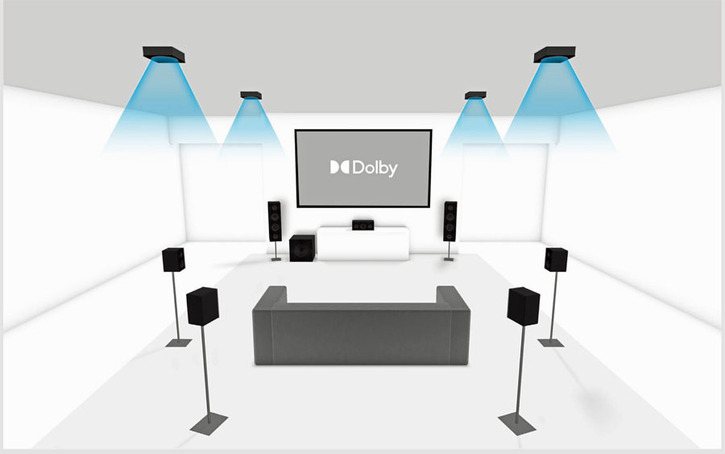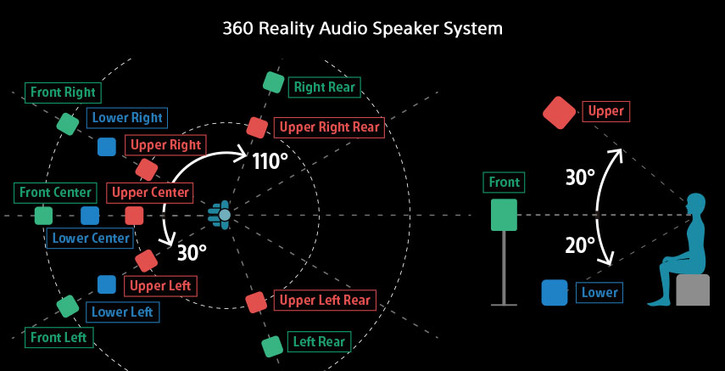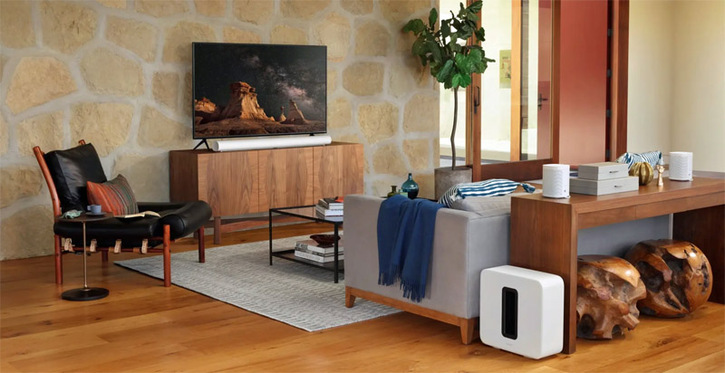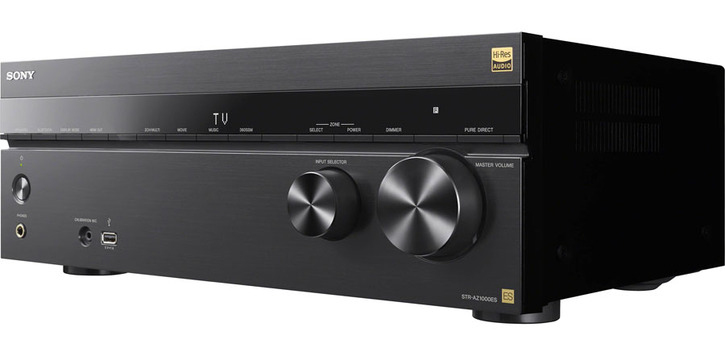The science of recording and reproducing sound has evolved significantly over the years. First there was monophonic sound (a single speaker), which was invented in the latter part of the 19th century. Monophonic (aka "mono") speakers could be effective at reproducing the sound of different voices and instruments but they could not reproduce the spaciousness or relative positions of sounds. Stereophonic sound ("stereo") came next, with early stereo reproduction systems appearing late in the 19th century. Stereo systems use two speakers (or headphones) to reproduce a sense of space, movement and directionality. But in real life, sound doesn't just come from in front of you, it comes from all around: in front, to the sides, above, and even occasionally below the listener. So surround sound was introduced in order to capture sounds from all directions.
The first instance of surround sound in movie theaters came in 1940, with the release of Walt Disney's "Fantasia." Walt Disney himself wanted movie viewers to be fully immersed in the action so the company, in partnership with Bell Labs, created its own multi-channel surround sound format called "Fantasound." In the "Flight of the Bumblebee" sequence, Walt wanted the audience to be able to track the bumblebee not just visually but with the sound of the bee travelling all around the theater. Ironically, the bumblebee scene ended up being cut from the film, and the cost of the 54-speaker system and the necessary amplifiers was too high for most theaters to implement. But this ground-breaking project eventually blossomed into the multi-billion dollar surround sound industry that we know today.
The main thing that differentiates "immersive sound" (also called "spatial audio") from regular surround sound is typically the addition of height information to the surround sound mix. Regular surround sound reproduces sound all around the listener, immersive sound reproduces sound from above (and sometimes below) the listener as well. Simply put, immersive sound is intended to completely envelop or immerse the listener in sound from all directions.
Immersive sound, also known as "3D surround sound" comes in several different flavors and formats. A format called "Auro 3D" was first demonstrated in 2006. This was the first surround sound format to include height elements. But Auro 3D had limited success in theaters and in the home market. The first object-based immersive surround sound format was Dolby Atmos which debuted in theaters in 2012 with the Disney/Pixar animated film "Brave." Soon after Dolby Atmos came DTS:X, another object-based immersive sound format. More recently, the MPEG H standard was released, and this includes a multi-channel immersive sound component. In 2019, Sony introduced its own variant of immersive sound called "360 Reality Audio" which is based on that MPEG-H audio standard.
In movie theaters and large venues, you can sometimes find dozens of speakers used to reproduce immersive sound. But the speaker requirements for home systems are somewhat less extensive. In home implementations, we typically see anywhere from eight speakers (5.1.2) to thirteen speakers (7.2.4) used for immersive sound. Some home solutions like soundbars use a technique called "channel virtualization" or reflective speakers to reduce the number of actual speaker cabinets required in the room.

While Dolby Atmos, Auro 3D and DTS:X all include a height component which can place sound above the listener, Sony's 360 Reality Audio format extends that further with the ability to capture and reproduce sound below ear level as well. If you think of Dolby Atmos as a "dome" of sound with sound coming from all around and above, 360 Reality Audio can create a full sphere of sound all around, above and below the listening position.
In the current implementation of 360 Reality Audio in home audio gear, speakers below ear level at the floor level, aren't actually an option (at least not yet). However, Sony does recommend that content producers implement a thirteen channel speaker reference system when mixing and mastering content in 360 Reality Audio format. That thirteen channel system has a traditional five channel surround sound system augmented by three front height speakers above the listener (left, center and front height), two rear height channels above the listener (left and right rear height) and three floor level speakers below the listener (left, center and right lower speakers).

If you don't have the option for thirteen speakers in your living room, don't fret! 360 Reality Audio, Dolby Atmos and DTS:X are object-based surround sound formats. This means that they can map sounds to whatever speaker configuration you have in your specific listening room. 5.1.2, 5.1.4, 7.1.2 and 7.1.4 are the most common speaker layouts for immersive sound, though high end receivers and processors can support even more speaker channels. Also, many speakers and soundbars reflect sound off the wall and ceiling so you can get immersive sound without a lot of wires or speaker boxes. You can find out what these numbers mean in our article on surround sound formats.
> What Does 5.1.2 and 7.2.4 mean for home theater?

If the three most important elements in real estate are "location, location, location" then the three most important elements of immersive surround are "content, content, content." It doesn't matter how great a system sounds if you can't find anything to watch or listen to on it. As the first widespread immersive audio format, Dolby Atmos got a huge headstart on the competition. A couple of years after its theatrical debut, Dolby Atmos was introduced into consumer electronics gear like receivers, speakers, TVs, Blu-ray Disc players and streaming boxes. The format also made its way onto physical media (Blu-ray Disc and Ultra HD Blu-ray) and onto the top streaming services including Netflix, Disney+, Amazon Prime Video, Vudu and HBO Max.
As of early 2023, there are thousands of movies and TV episodes available in Dolby Atmos immersive sound across a wide variety of media and streaming services. Meanwhile, AURO-3D and DTS:X titles are much less widely available. DTS may be poised to make a comeback soon as DTS:X immersive sound is a part of the "IMAX Enhanced" standard which was introduced in 2019.
Immersive sound/spatial audio has recently made its way into music releases. In the past few years, tens of thousands of music tracks have been released or remixed in Dolby Atmos. Music streaming services Apple Music, TIDAL and Amazon Music each now offer titles in Dolby Atmos immersive sound. Since 2019 when Sony 360 Reality Audio hit the music scene, that format has made its way into over 1,000 music tracks as well. The 2022 Grammy winner for immersive audio "Divine Tides" by Stewart Copeland and Ricky Kej was mixed and released in 360 Reality Audio and it's quite an impressive-sounding album in the format.

As with movies and TV shows, the best way to experience music in immersive sound is with speakers. But this isn't always convenient or feasible for many consumers and music lovers. Many folks are hesitant to make room in their living space for multiple speakers and for the wiring that frequently accompanies them. Also, the various music streaming services offer different levels of hardware support, so even if you buy a top of the line receiver or soundbar which supports Dolby Atmos and 360 Reality Audio, you may still have compatibility issues when trying to playback music tracks in a particular format through your streaming box, soundbar or receivers.
For those who want to experience music in immersive sound over speakers, check out these two reference articles over on eCoustics for the details:
> How (and Why) to Listen to Dolby Atmos Music over Speakers
> WTF is Sony 360 Reality Audio?
Immersive sound can also be enjoyed over headphones via a process called "binauralization." This process takes a multi-channel immersive sound mix and converts it into a 2-channel binaural mix which can be listened to on headphones. Based on psychoacoustic models and the HRTF (head related transfer function), binaural mixes can produce a fairly convincing simulation of sound coming from all directions.
It may not be as effective as listening out loud through multiple speakers, but it does allow listeners to enjoy their immersive sound mixes on the go, through a standard pair of headphones. This can be particularly effective for gaming, where knowing what direction a sound is coming from can make it more likely you can keep your character alive. You can check out a simple demo of binauralization in the DTS Headphone:X channel demo on YouTube.
Immersive sound takes surround sound to the next level with the addition of height information. A good immersive sound system can bring the viewer or listener right in the middle of the action in movies, games, TV shows and music. Immersive sound can be experienced with headphones but it is more effective through speakers. For those interested in exploring immersive sound there are home systems available at a wide range of price points.
Related Articles:
Get a Complete Dolby Atmos Home Theater System with Projector for Under $2,000
WTF is Dolby Atmos Music? (eCoustics)
WTF is 360 Reality Audio? (eCoustics)